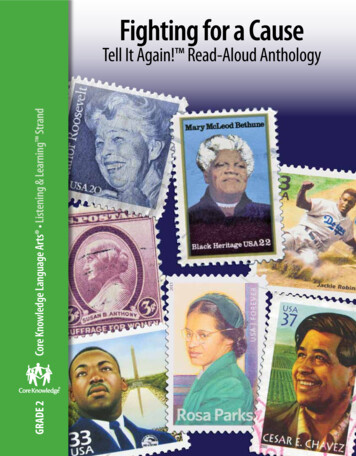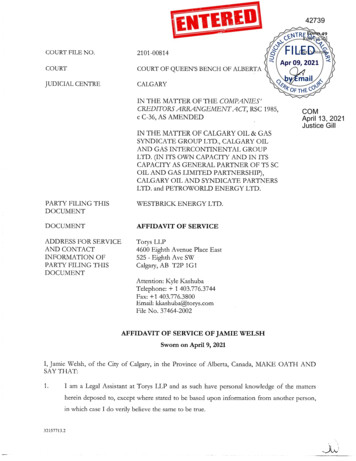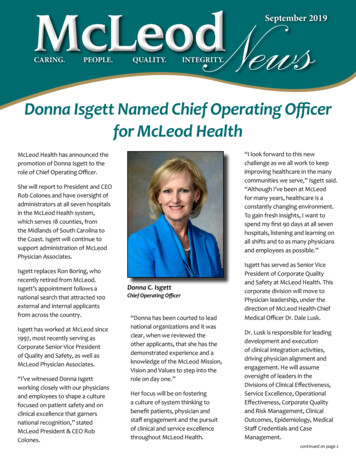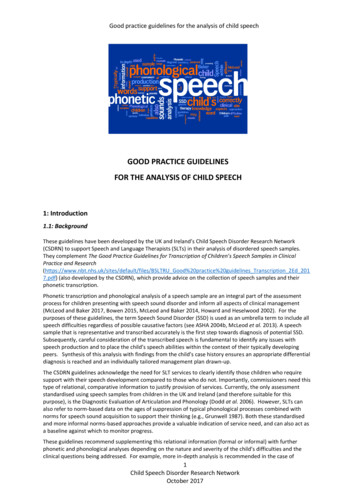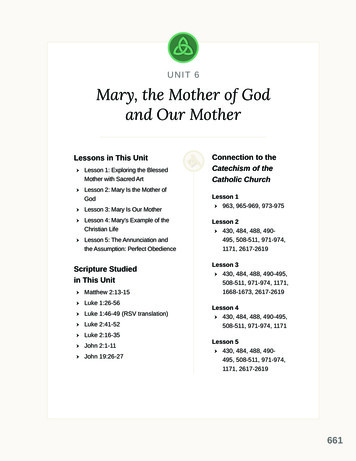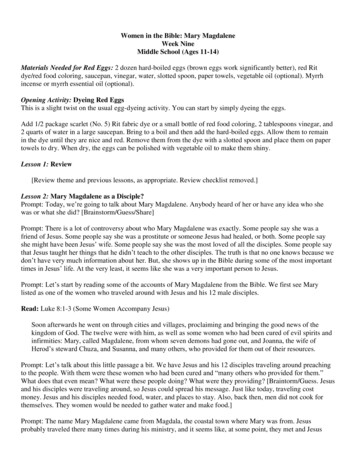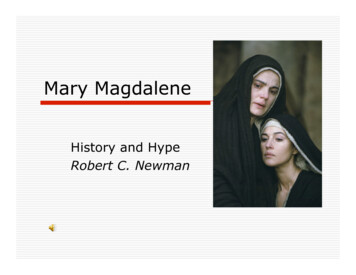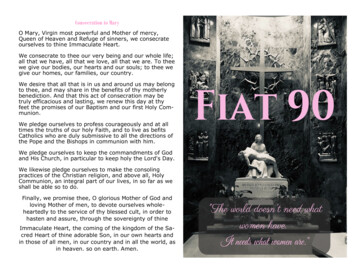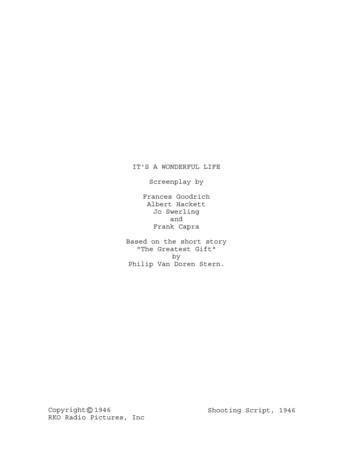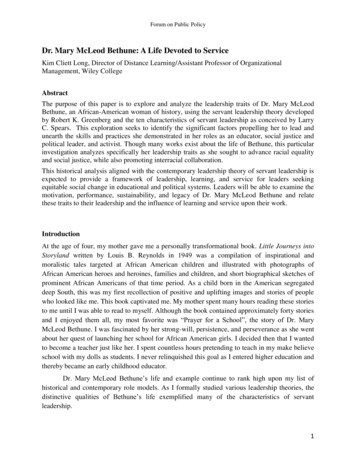
Transcription
Forum on Public PolicyDr. Mary McLeod Bethune: A Life Devoted to ServiceKim Cliett Long, Director of Distance Learning/Assistant Professor of OrganizationalManagement, Wiley CollegeAbstractThe purpose of this paper is to explore and analyze the leadership traits of Dr. Mary McLeodBethune, an African-American woman of history, using the servant leadership theory developedby Robert K. Greenberg and the ten characteristics of servant leadership as conceived by LarryC. Spears. This exploration seeks to identify the significant factors propelling her to lead andunearth the skills and practices she demonstrated in her roles as an educator, social justice andpolitical leader, and activist. Though many works exist about the life of Bethune, this particularinvestigation analyzes specifically her leadership traits as she sought to advance racial equalityand social justice, while also promoting interracial collaboration.This historical analysis aligned with the contemporary leadership theory of servant leadership isexpected to provide a framework of leadership, learning, and service for leaders seekingequitable social change in educational and political systems. Leaders will be able to examine themotivation, performance, sustainability, and legacy of Dr. Mary McLeod Bethune and relatethese traits to their leadership and the influence of learning and service upon their work.IntroductionAt the age of four, my mother gave me a personally transformational book. Little Journeys intoStoryland written by Louis B. Reynolds in 1949 was a compilation of inspirational andmoralistic tales targeted at African American children and illustrated with photographs ofAfrican American heroes and heroines, families and children, and short biographical sketches ofprominent African Americans of that time period. As a child born in the American segregateddeep South, this was my first recollection of positive and uplifting images and stories of peoplewho looked like me. This book captivated me. My mother spent many hours reading these storiesto me until I was able to read to myself. Although the book contained approximately forty storiesand I enjoyed them all, my most favorite was ―Prayer for a School‖, the story of Dr. MaryMcLeod Bethune. I was fascinated by her strong-will, persistence, and perseverance as she wentabout her quest of launching her school for African American girls. I decided then that I wantedto become a teacher just like her. I spent countless hours pretending to teach in my make believeschool with my dolls as students. I never relinquished this goal as I entered higher education andthereby became an early childhood educator.Dr. Mary McLeod Bethune’s life and example continue to rank high upon my list ofhistorical and contemporary role models. As I formally studied various leadership theories, thedistinctive qualities of Bethune’s life exemplified many of the characteristics of servantleadership.1
Forum on Public PolicyThe trait theory of leadership states that leaders often display certain characteristics thatmake them successful. Historical leaders antecedent to contemporary leadership theorydemonstrated qualities that notably were predicated on strength of character, native skills andother constructive personality indicators. This essay will juxtapose the leadership characteristicsdisplayed by Bethune using primary and secondary sources about her life and work with RobertK. Greenleaf’s theory of servant leadership and Larry Spears’ ten characteristics of servantleaders. Comparative analysis will provide a glimpse into Bethune’s leadership in contemporaryservant leadership terms and further examine the innateness of leadership traits.Servant Leadership LiteratureRobert K. Greenleaf coined the phrase ―Servant Leadership‖. In his now famous essay firstpublished in 1970, he said,The servant-leader is servant first It begins with the natural feeling that onewants to serve, to serve first. Then conscious choice brings one to aspire to lead.That person is sharply different from one who is leader first; perhaps because ofthe need to assuage an unusual power drive or to acquire materialpossessions The leader-first and the servant-first are two extreme types.Between them there are shadings and blends that are part of the infinite variety ofhuman nature.1With that definition in 1970, Greenleaf coined the term servant leadership and launched aquiet revolution in the way in which leadership is viewed and practiced. Today the concept ofservant leadership is increasingly viewed as an ideal leadership form to which untold numbers ofpeople and organizations aspire. In fact, we are witnessing today an unparalleled explosion of,interest in, and practice of, servant leadership.Many businesses and not-for-profit organizations are shifting away from the moretraditional autocratic and hierarchical models of leadership and toward servant leadership as away of being in relationship with others. Servant leadership seeks to involve others in decisionmaking, is strongly based in ethical and caring behavior, and enhances the growth of workerswhile improving the caring and quality of organizational life. In her groundbreaking book onquantum sciences and leadership, Rewiring the Corporate Brain, Danah Zohar goes so far as tostate that, ―Servant-leadership is the essence of quantum thinking and quantum leadership.‖ 2Since the early 1990s, servant leadership theorists have been refining the operationalthemes associated with servant leadership. The following authors—the servant leadershipvariables associated with each author are listed by their names—have been key in the theoreticalformulation of servant leadership based on Greenleaf’s (1977) initial framework: (a) Graham(1991)—inspirational and moral dimensions; (b) Buchen (1998)—self-identity, capacity for1Robert Greenleaf, Servant Leadership: A Journey into the Nature of Legitimate Power and Greatness (New York:Paulist Press, 1977), 7.2Danah Zohar, Spiritual intelligence: The ultimate intelligence. (New York: Bloomsbury, 2000), 146.2
Forum on Public Policyreciprocity, relationship building, and preoccupation with the future were essential themes; (c)Spears (1998)—listening, empathy, healing, awareness, persuasion, conceptualization, foresight,stewardship, commitment, and community building; (d) Farling et al. (1999)—vision, influencecredibility, trust, and service; (e) Laub (1999)—valuing people, developing people,building community, displaying authenticity, providing leadership, and sharing leadership; (f)Russell (2001)—vision, credibility, trust, service, modeling, pioneering, appreciating others, andempowerment; (g) Patterson (2003)—agape love, humility, altruism, vision, trust,empowerment, and service. Following this season of theory development in servant leadershipstudies, an increasing number of empirical servant leadership projects are being conducted andpresented in the literature.Biographical InformationAlthough Dr. Mary McLeod Bethune’s life story has been told countless times, this briefbiography is for the purpose of establishing her early experiences and subsequent leadershiproles as a backdrop to this analysis.Equal parts educator, politician, and social visionary, Dr. Mary McLeod Bethune, wasone of the most prominent African American women of the first half of the twentieth century andone of the most powerful. Bethune born July 10, 1875, the daughter and sister of former slaves,evidenced vision and innovation early in life when she, in one of her first displays of fortitudeand resolution, went about acquiring a primary education by walking five miles to a one roomschool for several years. Thus, she became the first member of her family of seventeen to attendschool. It might be speculated that one legacy of her family’s ordeal under the regime of slaveryresulted in her resolve to do all that was in her power to survive and thrive. Bethunedemonstrated leadership abilities, even as a child, for resolving conflicts, organizing projects,and looking out for the needs of others.3 She furthered her education by attending ScotiaSeminary, a school for African American women in North Carolina, on a scholarship providedby a teacher in Colorado who wanted to help an African American girl realize an education.Upon completion of her program, her benefactor paid for her to attend the Moody Bible Institutein Chicago. Her every intention was to serve as a missionary in Africa. The Presbyterian MissionBoard denied her request to serve stating that there were no missionary positions available forAfrican Americans in Africa. After a period of disappointment, Bethune came to the realizationthat ―Africans in America need Christ and school just as much as Africans in Africa My lifework lay not in Africa but in my own country.‖ 43C.G. Newsome, Mary McLeod Bethune in religious perspective: A seminal essay. (Unpub. Diss. Duke University),44,454Newsome, 433
Forum on Public PolicyHer teaching career was launched at her former school in Mayesville, South Carolina,then later, moving on to teach at Haines Normal and Industrial Institute in Augusta, Georgia. Shewas inspired by the founder and principal of the school, Lucy Laney’s commitment to servingothers.Bethune married Albertus Bethune, a clothes salesman in May 1898. They relocated toSavannah, Georgia and had a son in February 1899 and shortly afterward moved to Palatka,Florida where Bethune opened a mission school for impoverished African American children.In 1904, Bethune and her family moved to Daytona Beach, Florida, to enable her to opena school for the children of poor African American laborers on the Florida East Coast Railroad.She located a dilapidated building and persuaded the owner to accept 1.50 as a down paymentfor the eleven dollars per month rent.Bethune foraged for discarded supplies and found a barrel to use as a desk and crates forchairs. Later she wrote, ―I haunted the city dump and the trash piles behind hotels, retrievingdiscarded linen and kitchen ware, cracked dishes, broken chairs, pieces of old lumber.Everything was scoured and mended.‖ 5 Her ingenuity and resourcefulness led to the October,1904 opening of the Daytona Educational and Industrial Training School for Negro Girls withfive students attending who paid tuition of fifty cents per week.The school had grown to almost two hundred fifty students by 1906. To raise money for alarger facility, Bethune began fundraising by selling homemade ice cream, sweet potato pies, andperforming concerts. She also went door to door soliciting donations. Bethune later reminiscedabout this time, ―If a prospect refused to make a contribution, I would say, ―Thank you for yourtime. No matter how deep my hurt, I always smiled. I refused to be discouraged, for neither Godnor man can use a discouraged person. ‖ 6Finally, with the financial assistance of a few wealthy benefactors, Bethune was able topurchase land and build a brick school. This capacity to function in both the day-to-day existenceof education while at the same time doing what was necessary to keep the school fundeddisplayed the breadth of her leadership skills. Part of Bethune’s charisma was rooted in herphysical stature, in essence, her appearance.Mary McLeod Bethune made an impressive figure. Her rather large frame waswell-proportioned, enhanced by shapely ankles and truly beautiful expressivehands. The total effect of her physical appearance was one of strength and power,carried with grace and dignity She took pride in looking exactly as she did andwould not have wanted to change in any particular. But it was her luminous, hazeleyes, direct and candid, that caught and held the attention of all those who mether. 75Ralph Bullock, “Mary McLeod Bethune” in In Spite of Handicaps (Freeport, N.Y.: Books for Libraries Press,1927,1968), 103.6Bullock, 1047Rackham Holt, Mary McLeod Bethune: A Biography (Garden City, N.Y.: Doubleday, 1964), 72.4
Forum on Public PolicyBut not all of Bethune’s attributes were based on these external and often superficial,characteristics. Bethune was an eloquent speaker. Her training as a Presbyterian missionary hadresulted not just in the grasp of articulation which often accompanies education, but it unleashedeloquence more common in that era among male clergy and politicians.Nor was Mrs. Bethune, strictly speaking, a lecturer, in the sense that she wasenlightening an audience of adults who were paying in advance to be informedupon a subject on which the lecturer has specialized knowledge. Instead she was agifted speaker conducting a straight publicity campaign for the express purpose offundraising in order to operate and maintain said school. 8The school started by Bethune, The Daytona Literary and Industrial School for TrainingNegro Girls, would unite in 1923 with Cookman Institute to become Bethune-Cookman College.Though Bethune would remain at her school as a teacher and administrator for more than twentyyears, she would branch out her efforts to address broader issues than the education of youngAfrican American women. In an era marked by the activities of both W.E.B. DuBois and BookerT. Washington, Bethune focused her interest on the one group whose relationship would beclosest to that of African American children, that is, African American women.It would be her involvement in African American women’s issues which would propelBethune to the highest levels of American society and politics. Even when she enteredgovernment she never lost sight of the ordeal of the African-American woman, second-classbecause of race and gender.Even when Bethune might seem to be most deeply immersed in her school, at noperiod did she lose sight of her long-time dedication to the cause of AfricanAmerican women. Her twin obsessions—the progress of women and ofchildren—were intertwined and inseparable. 9Bethune began her club activity locally, but within short order she had applied herdynamic energies to her new interest. Within a few years of joining her first African Americanwomen’s club, she was elected President of the State Federation of Colored Women’s Clubs inFlorida. It was not long before she held the national presidency. In 1924, she was electedpresident of the National Association of Colored Women’s Clubs.In this highly visible post Bethune first drew the attention of the national politicalestablishment. In 1928, she was invited to attend the Child Welfare Conference called byPresident Calvin Coolidge. Later during the Hoover administration, she was invited to attend theNational Commission on Child Welfare. Finally, Bethune became more than just a figure whosepresence was both a symbol to her race and an indication of progress, she was appointed to serveon the Hoover Commission on Home Building and Home Ownership.Bethune’s leadership legacy was a testimony to courage.10 She displayed courage tochallenge racism, the courage to take on the responsibility of feeding, housing and educating8Holt, 110Holt, 18010Newsome, 4895
Forum on Public Policychildren, the courage to approach the elite for support, the courage to challenge presidents and inthe midst of it all Bethune considered herself first and foremost an educator.Mrs. Bethune’s quite justified appraisal of herself as an educator was more thanproved through her intuitive, administrative sense, and power as a lecturer. In thisfield she was not excelled. She had the uncanny knack of retaining and usingaptly words and phrases, and in creating object lessons by turning personalexperiences into richly adorned parables. 11Dr. Mary McLeod Bethune was an educator and a leader with the courage anddetermination to leave the world a better place than she found it. By her own words and example,Bethune demonstrated the value of education, a philosophy of universal love and the wise andconsistent use of political power in striving for racial and gender equality. Equally important tonote, Bethune was an astute business woman. Her business involvements included serving asPresident of Central Life Insurance Company of Tampa, Florida and as a Trustee of the AfroAmerican Life Insurance Company of Jacksonville, Florida. She also wrote numerous magazineand newspaper articles and contributed chapters to several books.In the final year of Bethune’s life, she invested her efforts toward the establishment of afoundation that ultimately would be located in her home on the campus of Bethune-CookmanCollege. The mission of the foundation included awarding educational scholarships, sponsoringan annual women’s conference, providing a chapel for interracial devotional retreats, andcollecting documents related to Bethune’s life. Bethune hoped the foundation would inspireongoing advancement of her life goals. She managed to raise the needed funds for the foundationand five days before her death, the filing cabinets arrived. At the end, Dr. Mary McLeod Bethuneacknowledged that the work of her life was filled with divine guidance and a daily awareness ofthe presence of God. Dr. Mary McLeod Bethune died on May 18, 1955 of heart failure in herDaytona home.Spears’ Ten Characteristics of Servant Leadership comparatively personified through thelife of Dr. Mary McLeod Bethune.After years of carefully researching Greenleaf’s original writings while serving as the executivedirector of the Greenleaf Center, Larry C. Spears identified a set of ten characteristics of theservant leader central to the development of this type leader. These ten characteristics contributeto the meaningful practice of servant leadership.Throughout the life of Dr. Mary McLeod Bethune, the subject of this essay, herleadership actions indicated characteristics of servant leadership occurring naturally as a calling.Servant leaders have a natural desire to serve others. This notion of having a calling to serve isdeeply rooted and value-based. Servant leaders have a desire to make a difference for otherpeople and will pursue opportunities to impact the lives of others. A servant leader is willing to11Holt, 1626
Forum on Public Policysacrifice self-interests for the sake of others. To have a calling cannot be taught. Unless a personhas a natural desire to serve, servant leadership will be elusive.Bethune’s perceptive personality and spiritually focused childhood birthed inneryearnings and vision that evolved throughout her lifetime. Servant leaders have a natural desireto serve others. This principle was evidenced often and early in Bethune’s life. In an interviewwith Johnson, she reminisced:My mother said when I was born I was entirely different from the rest In theordinary things the children engaged in I wouldn’t. I had the type of leadershiplike my mother. She said I was just different from the others. My taste for foodwas different. I would just look at it and not eat it. I had my own ideas about eventhat. I had just a different setting in my acceptance of things from the rest of thechildren, and she very early detected that I was just a little different. My oldersisters wanted to get married early. I had no inclinations that way. I had more of amissionary spirit—the spirit of doing things for others.12Bethune demonstrated leadership abilities, even as a child, for resolving conflicts,organizing projects, and looking out for the needs of others. 13 When Bethune was the age of 10,a new mission school for African Americans was opened in Bethune’s hometown by the Boardof Mission for Freedmen of the Trinity Presbyterian Church. 14 When Miss Emma Wilson, theteacher at the new mission school, approached Bethune’s parents, there was no doubt that shewas the one to attend. Bethune interpreted this event as miraculous evidence of a God-ordaineddestiny for her life and saw this as an opportunity for her and her family to move beyondservitude and poverty. 15 She began to believe that surely as the only educated person in herfamily, God had a purpose for her life. 16 Bethune walked five miles each way to thisrudimentary mission school.Schooling deepened the meaning of Bethune’s Christian faith to include service as wellas trust. She prayed fervently that she would find God’s purpose for her life and move beyondthe social conditions of enslavement. 17 Although the possibility of further education did not lookhopeful, Bethune’s sense of divine destiny was once again affirmed when a Quakerschoolteacher from Colorado offered to finance her education at Scotia Seminary, an institute inNorth Carolina that aimed to elevate the status of African American women by preparing them inmind, body, and spirit. 18 Transitioning to the Scotia Seminary context enlarged her world view,12Charles Johnson, Interview with Mary McLeod Bethune, (Florida Memory Project, Florida Department of State,Bureau of Archives and Records Management: 1939), 3313Newsome, 44-4514Holt, 1815Holt, 1916Holt, 2017Newsome, 66-6818Audrey Thomas McCluskey and Elaine Smith, eds, Mary McLeod Bethune: Building a Better World(Bloomington: Indiana University Press: 2001), 37
Forum on Public Policyas she was determined to learn as much as possible and prove herself worthy of this lifeexpanding opportunity.After completing 7 years at Scotia Seminary, Bethune headed to Moody Bible Institute inChicago for two years of missionary training, yet another opportunity in the unfolding revelationand affirmation of God’s purpose for her life. At Moody, Bethune’s Christian faith andcommitment to a life of missionary service grew stronger. Spears emphasized, ―a strong belief inthe ideological nature of a cause is necessary for one to develop the other leadership traits.‖ 19ListeningKnowledge is the prime need of the hour. BethuneListening intently to others is a characteristic exhibited by servant leaders. These leadersseek to identify and clarify the will of a group. They seek to listen receptively to what is beingsaid (and not said). People instinctively understand that servant leaders want them to share theirideas and that these ideas will be valued.Bethune listened to the needs of her family and community members from an early age.She conveyed to Johnson that ―I had gotten what I could at the Mission school and did all I couldin the community to keep alive the interest in education, keeping up intercession for anopportunity to train myself that I might be of service to others.‖ 20Later during her time at Scotia, she stated that ―homesick girls would always find me‖.Consequently, Bethune asserted ―that girls with their problems, difficulties, and disappointmentsalways would come to me for advice. I don’t know why, but I entered in the school life there justas I did in the little mission, finding things to do and people to serve.‖21.EmpathyFrom the first, I made my learning, what little it was, useful every way I could. BethuneServant leaders strive to ―walk in others’ shoes‖. All people need to be accepted andrecognized for their special and unique personhood. A servant leader will understand andempathize with the circumstances and problems of others. They will earn the confidence neededto lead by listening and not passing judgment, but being fully present in the situation beingexperienced.Bethune related to Johnson, ―when anyone was sick in the community, she would enticeher mother to make them some soup.‖22 She also wanted to share her shoes with children without19Larry Spears, Servant Leadership and the Greenleaf Legacy in L.C. Spears (Ed.) Reflections on Leadership: HowRobert K. Greenleaf’s Theory of Servant leadership Influenced Today’s Top Management Thinkers (New York:Wiley and Sons), 920Johnson, 3321Johnson, 3422Charles Johnson, Interview with Mary McLeod Bethune, (Florida Memory Project, Florida Department of State,8
Forum on Public Policyshoes‖.23 Her empathy extended to the magnitude that she stated ―As I got I gave I feel it in allthings, and I feel that as I give I get‖.24Bethune was able to embark on her incredible quest because of the educationalopportunities she was provided by missionary teachers and therefore, dedicated her life toensuring that all African American children had the opportunity to advance themselves througheducation.HealingIf our people are to fight their way up out of bondage we must arm them with the sword and theshield and the buckler of pride. BethuneOne of the great strengths of servant leaders is the potential for healing self and others. In―The Servant as Leader‖, Greenleaf wrote, ―There is something subtle communicated to one whois being served and led if, implicit in the compact between the servant leader and the led is theunderstanding that the search for wholeness is something that they have.‖25 The ability to createan environment that encourages emotional mending is crucial for those who want to becomegreat servant leaders.Bethune was raised in a God-conscious environment with intentional nurture in theChristian faith. 26This belief in Christian principles led Bethune to develop sensitivity andbenevolence toward others whatsoever their plight. Upon her death, columnist Louis E. Martinsaid, ―She gave out faith and hope as if they were pills and she some sort of doctor‖.27Bethune’s service to humanity reflected a philosophy of education that was truly from aJudeo-Christian perspective in the broadest and most inclusive sense of the term. She enabledAfrican Americans to move beyond the oppression and degrading conditions of servitude towardspiritual, economic, and political liberty. Bethune gave her whole self and her whole life to theadvancement of community, racial unity, and interracial cooperation.Reflectively, in her interview with Johnson, Bethune mused, ―possibly the first realwound that she could feel in her soul and her mind was the realization of the dense darkness andignorance that she found in herself—when she did find herself—with the seeming absence of aremedy‖.28 She elucidated that what she meant by that was the recognition of lack ofopportunity.Bureau of Archives and Records Management: 1939), 3723Johnson, 3924Johnson, 3925Larry Spears, Insights on Leadership: Service, Stewardship, Spirit, and Servant leadership(New York: Wiley andSons, 1998), p. 1226McCluskey and Smith, 52-5327Newsome, 4528Johnson interview, 249
Forum on Public PolicyAwarenessFaith is the first factor in a life devoted to service. Without it, nothing is possible. With it,nothing is impossible. BethuneGeneral awareness and especially self-awareness strengthens the servant leader, givingthem a keen sense of what is happening around them. They are always looking for clues from theenvironment to inform their options and decisions, maintaining their own inner-security. Theyare not absorbed into the problems of others nor are they surprised by them, yet servant leadersare informed and aware of the situations that surround them.Bethune had an unforgettable encounter with a white girl at the home of her mother’sformer master.29 While her mother was tending to some work, Bethune found herself in the midstof a playhouse filled with books and other school supplies. When she picked up a book, thewhite girl made it clear to Bethune that she could not read and led her to the picture books. Thisencounter left Bethune with life-altering self-awareness, a determination to read, and a drive torealize her calling to serve others by sharing her acquired knowledge.PersuasionCease to be a drudge, seek to be an artist. BethuneServant leaders rely on persuasion, rather than formal positional authority in makingdecisions. Servant leaders are naturally convincing and offer compelling reasons when theymake requests rather than coerce for compliance. This characteristic offers one of the clearestdistinctions between traditional leadership and servant leadership. The servant leader is effectiveat building consensus within groups.With the love and respect of the students and teachers, Bethune developed her naturalleadership abilities, such as advising students and negotiating with school authorities for changesin the seminary. Through the values, instruction, and human care at Scotia, Bethune’s self-image,and sense of worth and dignity grew strong.30ConceptualizationI never stop to plan. I take things step by step. BethuneServant leaders seek to nurture their abilities to ―dream great dreams.‖ This alsoencourages others to dream great dreams and avoid getting bogged down by the day-to-dayrealities and operations. Servant leaders balance creative thinking and bringing the world, eventsand possibilities together. No situation remains in isolation or in a problematic state through theefforts of conceptualization.2930Holt, 18-19McCluskey and Smith, 43-4410
Forum on Public PolicyAn early biography on Bethune by Clarence Newsome suggested ―she approached lifewith a single vision, a firm conviction of an underlying unity in all dimensions of life includingspiritual, social, and political‖.31 Believing that education provided the key to racialadvancement, she conceptualized and then founded the Daytona Normal and Industrial Institute,Florida (1904), which through her persistent direction as president (1904–42) became BethuneCookman College (1929).32ForesightInvest in the human soul. Who knows, it might be a diamond in the rough. BethuneForesight is a characteristic that enables servant leaders to understand lessons from thepast, the realities of the present, and the likely consequence of a decision in the future. It isdeeply rooted in the intuitive mind. Servant leaders are adept at picking up the patterns in theenvironment and predicting what the future will bring.With a strong sense of divine guidance, Bethune left her work in Palatka, Florida with adetermination to start a school in a destitute area of Daytona Beach, Florida. While faced withopposition and insults, she saw the African American community of Daytona as a needy missionfield with potential and opportunity.33 Bethune believed that progress of the race could beensured through liberally educated African American women.34Bethune
Although the book contained approximately forty stories . School‖, the story of Dr. Mary McLeod Bethune. I was fascinated by her strong-will, persistence, and perseverance as she went about her quest of launching her school for African American girls. I decided then that I wanted to become a teacher just like her. I spent countless hours .
